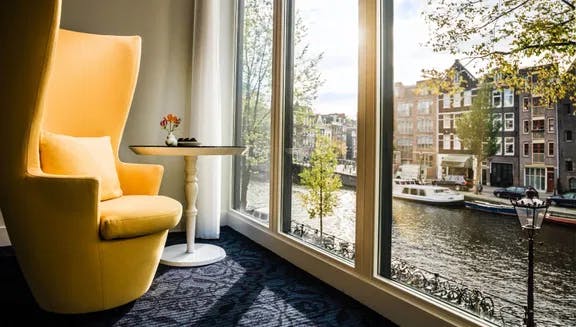
Historic meeting spaces in Amsterdam
Sofitel Legend the Grand

Beginning in 1411 as two convents - St. Catharinaklooster and Ceciliënklooster – The Grand has evolved considerably throughout history. After the Reformation movement, it operated briefly as a lodging house until seized by the Admiralty in the mid-17th century to be used for local government. During Napoleon Bonaparte's reign, the building became temporary royal quarters but later resumed civic duties and served as city hall until 1987. The Grand also features the artistic works of renowned artist Karel Appel, showcasing its evolution across time while preserving mementos from its eventful past.
Sofitel Legend the Grand Amsterdam | Oudezijds Voorburgwal 197
Hotel Arena

Built originally as Saint Elisabeth Gesticht – a 19th-century Amsterdam Catholic girls’ orphanage - Hotel Arena has seen several transformations. During World War II, it housed medical departments, sheltered the homeless postwar, and turned into Sleep Inn in the late 1970s. In 1992, it was rebranded as a hotel, evolving to today’s prestigious four-star boutique property. Throughout its journey, Hotel Arena has hosted artist events, implemented green initiatives in rooms and introduced “The Top Suite” for premium accommodation options while preserving the original orphanage’s adapted chapel. A designated monument, this building boasts distinct architectural elements like timber framing and marble columns. The restored chapel, with its breathtaking frescoes and stained glass windows, is one of the unique and atmospheric rooms available for hosting events.
Hotel Arena | 's-Gravesandestraat 55
Beurs van Berlage

The emblematic Beurs van Berlage – a national Dutch landmark with roots dating from the 17th century. It was revamped by late-19th-century architect Hendrik Petrus Berlage, who envisioned a volkspaleis (folks palace). Completed in 1903, the building features elements that foreshadow Bauhaus and Amsterdam School aesthetics, prominently showcased through its iconic "Beursbengel" (stock exchange) bell tower. It was awarded as one of the millennium's top thousand buildings in 1999. Today, it is a multifunctional venue hosting large conferences within a 16k m² space alongside offices, two restaurants and escape rooms.
Beurs van Berlage | Damrak 243
Royal Concertgebouw

The renowned Royal Concertgebouw (concert hall) Amsterdam – designed by Adolf Leonard van Gendt - was constructed outside city limits between 1883-88. A centre for grand composers such as Bach and Beethoven, it later drew illustrious foreign artists. In the 1980s, Pi de Bruijn completed a renovation to address subsidence issues. A new wing was added that improved rehearsal spaces and entrances while also preserving and restoring the original 1890 organ. With late Romantic acoustics in the main hall and an intimate recital hall, this landmark is a stunning global landmark and a prime destination for exceptional events.
Royal Concertgebouw | Concertgebouwplein 10
Arti et Amicitiae

Established in 1839 on Amsterdam's Rokin Street, 'Arti et Amicitiae' (Latin for ‘Art and Friendship’) is a prominent Dutch artistic society that promotes the art scene within the Netherlands. It supports artists, enthusiasts and offers pension provisions to its members. Emerging during Napoleon’s attempt to disband painters' guilds in 1794, it became an outlet for artists’ gatherings. Its iconic white neoclassical facade – constructed in 1855 under architect J.H. Leliman symbolises unity across different art forms: architecture, painting, engraving and sculpture. Initially operating as "Grand Salon Dupond" catering to elite crowds , 'Arti' secured royal patronage under King William II through his membership status.
Arti et Amicitiae | Rokin 112

Discover more venues with our Venue Finder.
Related articles

Meeting venues with the best views

Large conference venues

Venues in the Amsterdam Area

Sustainable venues

Top event venues in the Schiphol Airport area

Meeting venues for smaller groups

Meeting venues on the canals

Top meeting venues in regional gems of Amsterdam Area

Venues for social events
